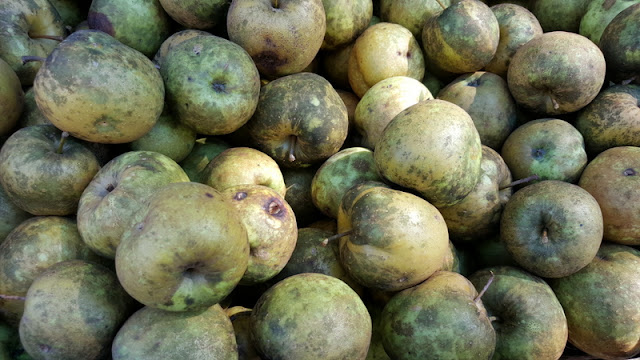My friend Robair recently commented, "Every time I read your blog, I learn something new about something I'd like to eat."
Not this time, baby.
I should be upfront with the news: Sooty Blotch is not actually an item of produce, though it's fun to imagine asking a vendor for 2 lbs. of it. Nor is "sooty blotch" a vivid insult, though it sounds like an entry in the Urban Dictionary.
Rather, sooty blotch is the first, and probably the last, non-produce entrant in the "What the heck is that?" category.
Sooty blotch is a fungus.
Sooty blotch isn't a tasty fungus like mushrooms or huitlacoche, the Mexican corn fungus that is also known, hilariously, as corn smut. Sooty blotch is the fungus that gives meaning to the term "no spray."
Sooty blotch is associated with wet summers, and can affect other fruit besides apples - pears, grapes and plums are also favorites of the fungus. Farmers can treat their crops with fungicides or simply prune the trees more aggressively during the winter, since better air circulation means better drying in the wet warm weather.
Seeing unsprayed apples is like seeing one of those "Shocking and Unrecognizable: Stars Without Make-up!" articles that celebrity magazines love to publish. Wow, is that a blemish on Beyonce? You mean it takes work for Katy Perry to look glamorous?
You mean apples would like this without anti-fungal spray?
Listen to Iowa State University's plant pathologists discuss sooty blotch and hear the echoes of feminist deconstructions of the conventions of beauty. As one pathologist noted mournfully, "People know what a good apple looks like. They're used to the Disney World-looking apples." Another pathologist added, "It's devastating if you're the grower," saddled with apples unfit for the consumer's gaze, suitable "only... for juice and in pies."
I notice that even organic apples sometimes feel the pressure to be beautiful, especially if they're jockeying for attention in a gourmet market.
Meanwhile the dreaded fungus is by all accounts tasteless and harmless. "Give the skin a good scrubbing if it bothers you," one vendor at the Union Square Greenmarket told me. "Or scrape it off with your nail. That is, if it bothers you." He was right - there was no taste difference, and some of the discoloration did come off on my cloth when I gave a few wipes.
Today I bought a perfect-looking apple. But lovely on the outside did not guarantee perfection on the inside. Nature often surprises.
Hmmm...could this become a selling point?

























